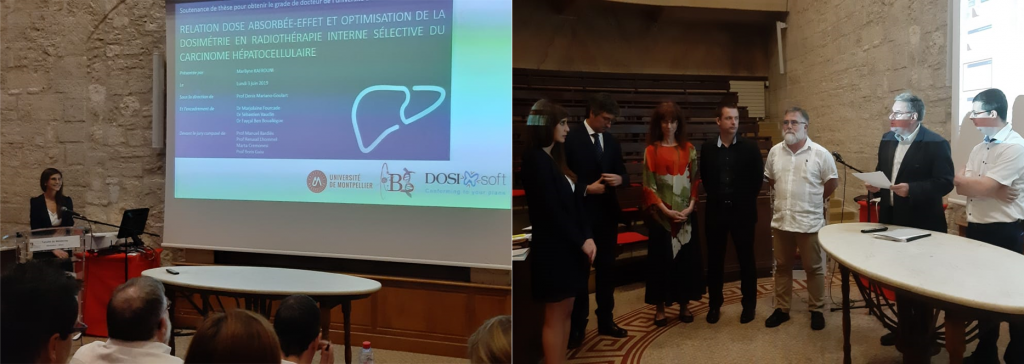- June 13, 2019
- Category: What's New
 *Dose-effect relationship and dosimetry optimization for selective internal radiation therapy of hepatocellular carcinoma
*Dose-effect relationship and dosimetry optimization for selective internal radiation therapy of hepatocellular carcinoma
Marilyne Kafrouni a in collaboration with CHU de Montpellier
PhD Thesis completed on June 3rd 2019
Selective internal radiation therapy (SIRT) is a growing therapeutic alternative for unresectable primary and secondary liver cancer. The principle is based on the intra-arterial administration of yttrium-90 loaded microspheres for tumor cell destruction through irradiation.
Yttrium-90 activity to be administered to the patient is, at the moment, usually prescribed using semi-empirical or barely personalized approaches that can be easily clinically implemented. New tools, similar to the ones used in external beam radiotherapy, are available today. These tools, which are not yet widely spread, require clinical feedback to show their benefits and guide the clinical application. Besides, a simulation stage is always performed before SIRT treatment itself. This two-step procedure implies differences (in terms of particles used, imaging modality, vascular flow modifications, etc.) that could potentially lead to dose deviations between planning and treatment. The thesis project comes within this scope, dealing with dosimetry optimization for hepatocellular carcinoma SIRT.
Delivered doses during 42 treatment procedures performed between 2012 and 2015 at Montpellier University Hospital, were retrospectively calculated at the voxel level using a dosimetry dedicated software (PLANET Dose, DOSIsoft, Cachan). Two complementary studies were carried out from this work. The first one analyzed dose data (average dose, dose volume histograms) versus patient follow-up including tumor response, liver toxicity and patient survival. The results obtained are consistent with the other teams, confirming the dose-effect relationship in SIRT. The second study highlighted the limitations of the BSA (body surface area) model that was used for activity planning. In particular, the limitations of this model to predict delivered dose and consequently treatment efficiency were quantitatively demonstrated. The lack of dosimetry and heterogeneity distribution considerations were also discussed. These two studies emphasized the interest for yttrium-90 activity planning based on individualized dose data.
A third study was conducted on a population of 23 patients treated between 2015 and 2018 at Montpellier University Hospital. The aim was to compare predictive and post-treatment dosimetry calculated at the voxel level. The clinical results were supported by phantom (simple and anthropomorphic) experimentations. A good correlation was observed highlighting the predictive value of dosimetry planning. However, a significant deviation was noticed and seems to be partly related to yttrium-90 TEP quantification. In addition, it was also noted that the radiological gesture can affect particle distribution and consequently dose distribution, this is why reproducibility as perfect as possible is required between the two stages.
